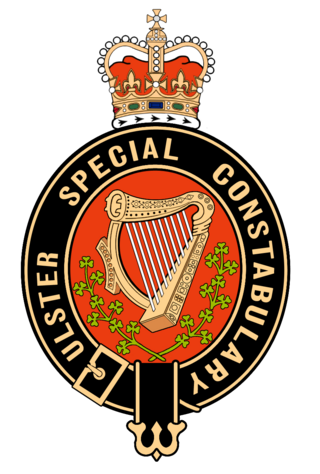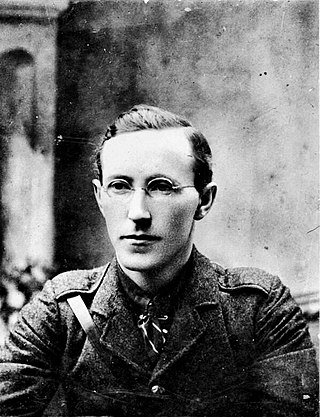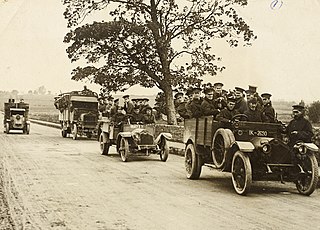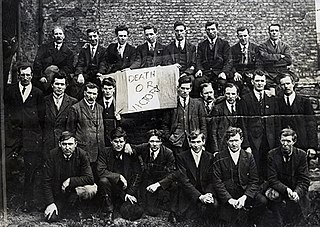Related Research Articles

The Irish Republican Army was an Irish republican revolutionary paramilitary organisation. The ancestor of many groups also known as the Irish Republican Army, and distinguished from them as the "Old IRA", it was descended from the Irish Volunteers, an organisation established on 25 November 1913 that staged the Easter Rising in April 1916. In 1919, the Irish Republic that had been proclaimed during the Easter Rising was formally established by an elected assembly, and the Irish Volunteers were recognised by Dáil Éireann as its legitimate army. Thereafter, the IRA waged a guerrilla campaign against the British occupation of Ireland in the 1919–1921 Irish War of Independence.

The Irish War of Independence or Anglo-Irish War was a guerrilla war fought in Ireland from 1919 to 1921 between the Irish Republican Army and British forces: the British Army, along with the quasi-military Royal Irish Constabulary (RIC) and its paramilitary forces the Auxiliaries and Ulster Special Constabulary (USC). It was part of the Irish revolutionary period.

Francis Thomas Aiken was an Irish revolutionary and politician. He was chief of staff of the Anti-Treaty IRA at the end of the Irish Civil War. Aiken later served as Tánaiste from 1965 to 1969 and Minister for External Affairs from 1951 to 1954 and 1957 to 1969. Previously he had held the posts of Minister for Finance from 1945 to 1948, Minister for the Co-ordination of Defensive Measures 1939 to 1945, Minister for Defence from 1932 to 1939, and was also Minister for Lands and Fisheries from June–November 1936.

The Ulster Special Constabulary was a quasi-military reserve special constable police force in what would later become Northern Ireland. It was set up in October 1920, shortly before the partition of Ireland. The USC was an armed corps, organised partially on military lines and called out in times of emergency, such as war or insurgency. It performed this role most notably in the early 1920s during the Irish War of Independence and the 1956–1962 IRA Border Campaign.
Events from the year 1920 in Ireland.

William Fanaghan Lynch was an Irish Republican Army officer during the Irish War of Independence of 1919–1921. During much of the Irish Civil War, he was chief of staff of the Irish Republican Army. On 10 April 1923, Lynch was killed whilst trying to escape an encirclement by Free State troops in south Tipperary.

The partition of Ireland was the process by which the Government of the United Kingdom of Great Britain and Ireland (UK) divided Ireland into two self-governing polities: Northern Ireland and Southern Ireland. It was enacted on 3 May 1921 under the Government of Ireland Act 1920. The Act intended both territories to remain within the United Kingdom and contained provisions for their eventual reunification. The smaller Northern Ireland was duly created with a devolved government and remained part of the UK. The larger Southern Ireland was not recognised by most of its citizens, who instead recognised the self-declared 32-county Irish Republic. On 6 December 1922 Ireland was partitioned. At that time the territory of Southern Ireland left the UK and became the Irish Free State, now known as the Republic of Ireland.

This is a timeline of the Irish War of Independence of 1919–21. The Irish War of Independence was a guerrilla conflict and most of the fighting was conducted on a small scale by the standards of conventional warfare.
The Irish Republican Army was a guerrilla army that fought the Irish War of Independence against Britain from 1919 to 1921. It saw itself as the legitimate army of the Irish Republic declared in 1919. The Anglo-Irish Treaty, which ended this conflict, was a compromise which abolished the Irish Republic, but created the self-governing Irish Free State, within the British Empire. The IRA was deeply split over whether to accept the Treaty. Some accepted, whereas some rejected not only the Treaty but also the civilian authorities who had accepted it. This attitude eventually led to the outbreak of the Irish Civil War in late June 1922 between pro- and anti-Treaty factions.

Séumas Robinson was an Irish republican and politician.

Joseph McKelvey was an Irish Republican Army officer who was executed during the Irish Civil War without trial or court martial. He participated in the Anti-Treaty IRA's repudiation of the authority of the Dáil Éireann, the civil government of the Irish Republic declared in 1919 in March 1922, and was elected to the IRA Army Executive. In April 1922, he helped command the occupation of the Four Courts in defiance of the new Irish Free State. This action helped to spark the civil war, between pro- and anti-treaty factions. McKelvey was among the most hardline of the republican side and, briefly in June 1922, became IRA Chief of Staff.
William John Twaddell was a Unionist politician from Belfast.
HMS Argenta was a prison ship of the British Royal Navy.

The Belfast Brigade of the Irish Republican Army (IRA) was formed in March 1921 during the Irish War of Independence, when the IRA was re-organised by its leadership in Dublin into Divisions and Joe McKelvey was appointed commander of the Third Northern Division, responsible for Belfast and the surrounding area. There were three battalions within the Brigade, the 1st in West Belfast, the 2nd in North Belfast and the Third in East Belfast. Most of the Brigade's attacks on Crown forces were carried out by an Active Service Unit within the 1st battalion, led by Roger McCorley. McCorley and Seamus Woods were leaders of a very active IRA Active Service Unit in Belfast which targeted the Royal Irish Constabulary (RIC) - Auxiliaries and Black and Tans.
Roger McCorley was an Irish republican activist.
The McMahon killings or the McMahon murders occurred on 24 March 1922 when six Catholic civilians were shot dead at the home of the McMahon family in Belfast, Northern Ireland. A group of police officers broke into their house at night and shot all eight males inside, in an apparent sectarian attack. The victims were businessman Owen McMahon, four of his sons, and one of his employees. Two others were shot but survived, and a female family member was assaulted. The survivors said most of the gunmen wore police uniform and it is suspected they were members of the Ulster Special Constabulary (USC). It is believed to have been a reprisal for the Irish Republican Army's (IRA) killing of two policemen on May Street, Belfast the day before.
Charlie Daly, born in Castlemaine, County Kerry, was the second son of Con. W. Daly, of Knockanescoulten, Firies, County Kerry. He went to school, first to Balyfinane National School, and later to the Christian Brothers at Tralee.
The Arnon Street killings, also referred to as the Arnon Street murders or the Arnon Street massacre, took place on 1 April 1922 in Belfast, Northern Ireland. Six Catholic civilians, three in Arnon Street, were shot or beaten to death by men who broke into their homes. It is believed that policemen carried out the attack, members of either the Ulster Special Constabulary (USC) or Royal Irish Constabulary (RIC), in retaliation for the killing of an RIC officer by the Irish Republican Army (IRA).
Bloody Sunday or Belfast's Bloody Sunday was a day of violence in Belfast, Northern Ireland on 10 July 1921, during the Irish War of Independence. The violence erupted one day before a truce began, which ended the war in most of Ireland. With the truce nearing, police launched a raid against republicans, but were ambushed by the Irish Republican Army (IRA) and an officer was killed. In retaliation, Protestant loyalists attacked Catholic enclaves in west Belfast, burning homes and businesses. This sparked rioting and gun battles between Protestants and Catholics, including paramilitaries. There were also gun battles between republicans/nationalists and the police, and some police patrols fired indiscriminately at Catholic civilians. Seventeen people were killed or fatally wounded on 10 July, and a further three were killed or fatally wounded before the truce began at noon on 11 July. At least 100 people were wounded. About 200 houses were destroyed or badly damaged, most of them Catholic homes, leaving 1,000 people homeless. See: The Troubles in Northern Ireland (1920–1922).

The Troubles of the 1920s was a period of conflict in what is now Northern Ireland from June 1920 until June 1922, during and after the Irish War of Independence and the partition of Ireland. It was mainly a communal conflict between Protestant unionists, who wanted to remain part of the United Kingdom, and Catholic Irish nationalists, who backed Irish independence. During this period, more than 500 people were killed in Belfast alone, 500 interned and 23,000 people were made homeless in the city, while approximately 50,000 people fled the north of Ireland due to intimidation. Most of the victims were Nationalists (73%) with civilians being far more likely to be killed compared to the military, police or paramilitaries.
References
- ↑ McDermott, Jim, (2001), Northern Divisions The Old IRA and the Belfast Pogroms 1920-22, BTP Publications, Belfast, pg 45, ISBN 1-900960-11-7
- ↑ Lynch, Robert, (2006), The Northern IRA and the Early Years of Partition, Irish Academic Press, Portland, pg 70, ISBN 0-7165-3378-2
- ↑ McDermott, pg 28-29
- ↑ "The British soldier who joined 1916 Easter Rising on leave". The Irish News. Belfast. 12 December 2015. Retrieved 29 August 2021.
- ↑ Lynch pg 74.
- ↑ Eunan O'Halpin & Daithí Ó Corráin. The Dead of the Irish Revolution. Yale University Press, 2020. p. 281
- ↑ O'Halpin, pg 393
- ↑ O'Farrell, Padraic (1997). Who's Who in the Irish War of Independence - Civil War 1916-1923. Lilliput Press. p. 101. ISBN 9781874675853.
- ↑ Lynch, pg 21.
- ↑ Phoenix, Eamon, (1994), Northern Nationalists, Ulster Historical Foundation, Belfast, pg 218, ISBN 0-901905-64X
- ↑ Glennon, Kieran, (2013), From Pogrom to Civil War, Mercer Press, Cork, pg. 286, ISBN 9781781171462
- ↑ Thorne Kathleen, (2014) Echoes of Their Footsteps, The Irish Civil War 1922-1924, Generation Organization, Newberg, OR, pg 187, ISBN 978-0-692-245-13-2
- ↑ "An Irishmans Diary". The Irish Times. Dublin. 3 September 2001. Retrieved 29 August 2021.
- ↑ Lynch pg 71.
- ↑ Phoenix pg 229.
- ↑ Hopkinson, Michael (2002). Green Against Green. New York: St. Martins Press. p. 84. ISBN 0-312-02448-7.
- ↑ Parkinson, Alan F. (2004), Belfast's Unholy War, Four Courts Press, pg 270, ISBN 1-85182-792-7
- ↑ Glennon, pg 121.
- ↑ Concannon, Patrick (12 August 2019). "Michael Collins, Northern Ireland and the Northern Offensive, May 1922". The Irish Story. Retrieved 25 March 2024.
- ↑ BBC: Camp Twaddell: Who was the man behind the name?
- ↑ Lynch pg 181.
- ↑ Cottrell, Peter, (2008),The Irish Civil War 1922-23, Osprey Pub, Oxford, pg 92, ISBN 978-1846032707
- ↑ McDermott, pg 254.
- ↑ McDermott, pg. 266.
- ↑ Glennon, pg 187.
- ↑ Parkinson, pg 215
- ↑ Woods, Seamus (29 September 1922). Seamus Woods to Richard Mulcahy (Dublin) (Speech). Documents on Irish Foreign Policy. Retrieved 25 March 2024.
- ↑ Kleinrichert, Denise, (2001), Republican internment and the prison ship Argenta 1922, Irish Academic Press, pg. 76, ISBN 978-0-7165-2683-4
- ↑ Thorne, pg 257.
- ↑ McDermott, pg 273.
- ↑ McDermott, pg 273.